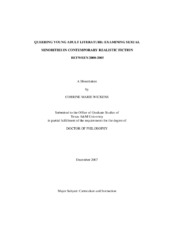| dc.description.abstract | Fiction that incorporates gay, lesbian, bisexual, transgender, or questioning of
heterosexuality itself (GLBTQ) themes and characters has been noted among the most
widely censored novels for young adults (ALA, 2007; Finnessy, 2002; Karolides, 2002).
Despite many teachers’ and librarians’ anxiety about even recommending a novel that
includes homosexual characters, more novels with GLBTQ characters and themes are
receiving significant literary accolades and awards. Furthermore, acclaimed researcher
and young adult literary historian, Michael Cart (2004) notes that reading young adult
literature, “the quintessential literature of the outsider,” provides “the lifesaving
necessity of seeing one’s own face reflected in the pages of a good book and the
corollary comfort that derives from the knowledge that one is not alone” (p. 46). For
GLBTQ youth, this is exceptionally important given the heteronormative structures in
place to monitor and control sexual and gender identities and expressions.
With this in mind, I utilized a dynamic and multi-faceted analytic approach,
including interpretivist, textual discursive, and literary analyses, to examine seventeen
GLBTQ themed novels for images, characterizations, and messages depicted about nonconforming sexualities and gender identities. I sought to answer three primary
questions: 1) What are the networks or systems of power that are unveiled as inhibiting
the identities of the characters? 2) How are the identities of these characters constructed?
3) What messages do the texts convey regarding nonconforming sexual and gender
identities?
I found that the authors largely created dynamic, three-dimensional characters
with complex histories and narratives that affirm and validate GLBTQ identities.
Moreover, I observed two overarching set of factors: one that encompasses culturally
mediated forces, which include cultural institutions and practices, persecution, and social
networks, and a second that emphasizes a critical modernist construction of identity.
Additionally, I found a progressive-oriented didacticism pervasive through the texts that
positively portrays GLBTQ characters, denounces homophobia, frequently challenges
heteronormative assumptions and behaviors, and instructs readers about various issues
and conflicts common to GLBTQ youth. | en |


